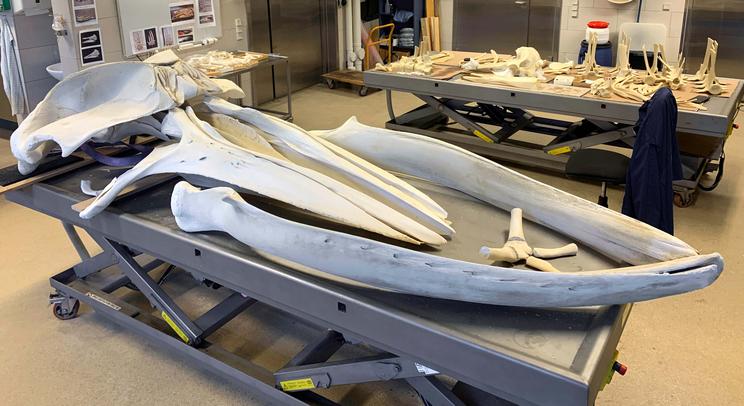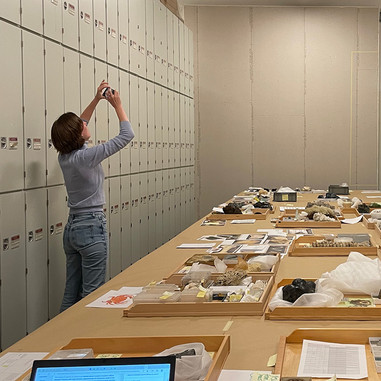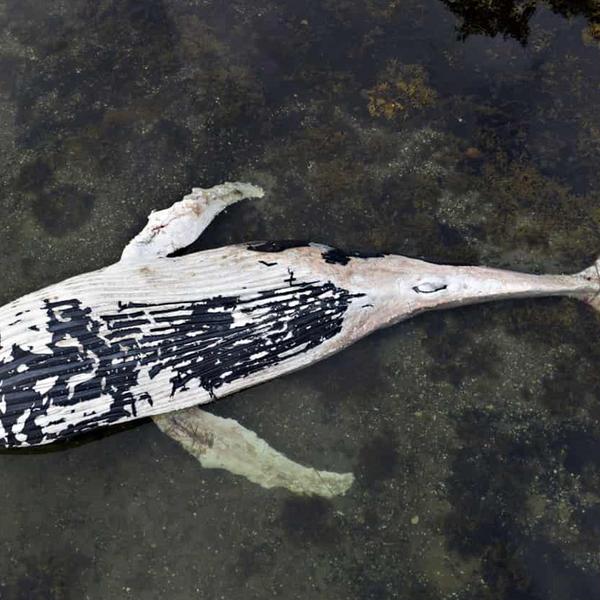
Extracting whale bones – in a challenging setting
By Mikkel Høegh Post
Over the last two decades we have had an impressive number of whale strandings. A number of sperm whales, two fin whales, two humpback whales, a sei whale, a bottlenosed whale, two Sowerby’s beaked whale and the first Cuvier’s beaked whale.
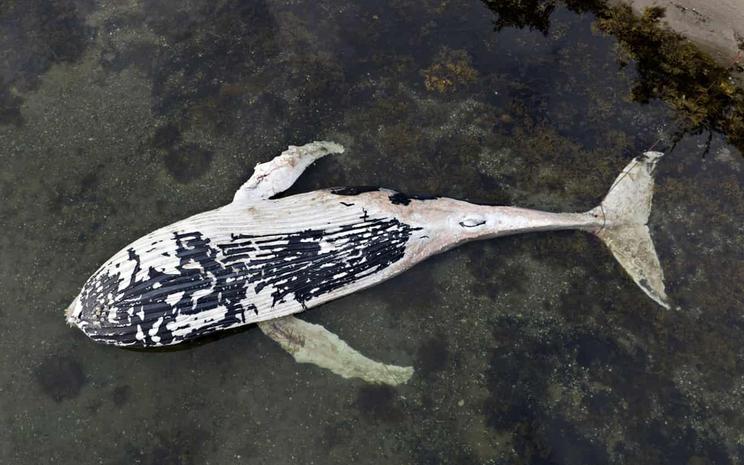
Very common (not all collected): Harbour porpoise.
Common (only skulls collected): Minke whale + White-beaked dolphin + Sperm Whale (including mass strandings of up to 17 males)
Uncommon to rare (complete skeletons collected):
Dolphins: Bottle nose dolphin, Common dolphin, White-sided dolphin, Long-finned pilot whale, Killer-whale (now rare), False killer-whale, Striped dolphin.
Whales: Bottle-nosed whale, Sowerby’s Beaked whale, Fin whale (3), Sei whale (3), Blue whale (2), Risso’s Dolphin (1), Bryde’s whale (1), Cuvier’s Beaked whale (1)
At 8.3 meters, the stranded Humpback whale was clearly a juvenile as adults range from 14-17 meters. It was likely only a few years old based on the length according to this paper.
Based on the position of the genital opening and the presence of mammal glands, the whale was identified as female.
As Denmark have a very long coastline and shallow waters, we have frequent dolphin and whale strandings.
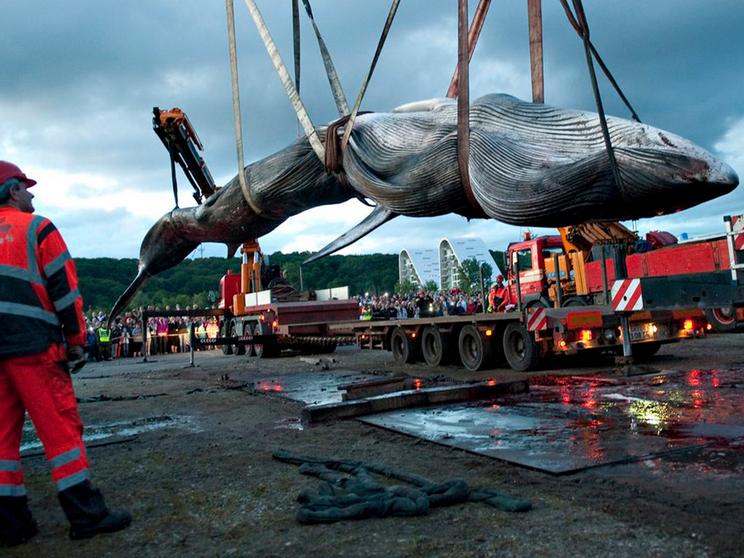
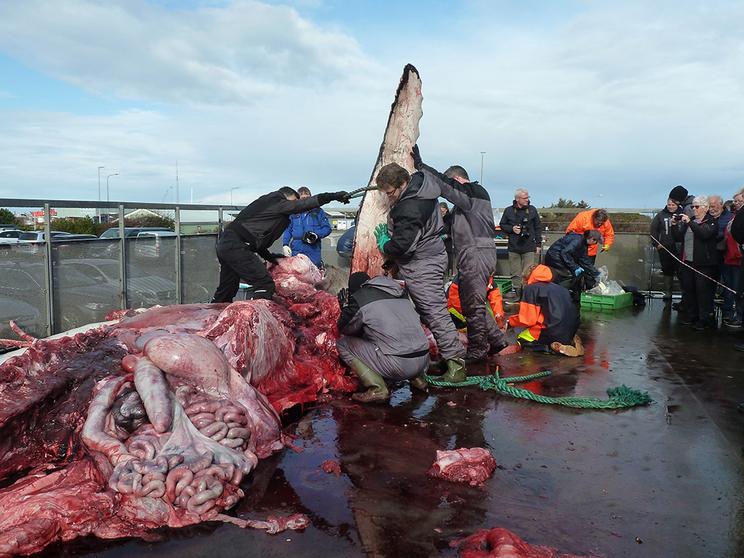
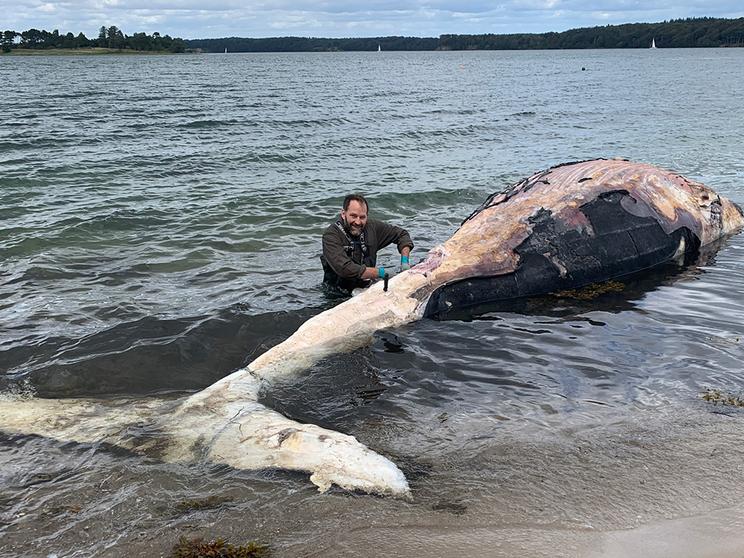
In a typical whale stranding, a combined team from Natural History Museum Denmark and other institutions (researchers, veterinarians etc.) would do an on-site autopsy and dissection of the whale to secure biological samples and the complete skeleton.
This case was different for several reasons: the carcass was too rotten to sample internal structures (organs etc.), many of the relevant people were on vacation, the whale was positioned partly in deep water (harsh working conditions), and access was limited to a gravel road through the forest, making a full dissection difficult.
The authority responsible, the Danish Nature Agency (Ministry of Environment of Denmark), decided to leave the carcass to natural decaying processes, which hasn’t happened in several decades in Denmark. As Natural History Museum Denmark still wished to (and has a responsibility to) secure important skeletal samples from all rare, stranded sea animals, I took several trips to the whale carcass to collect essential skeletal elements.
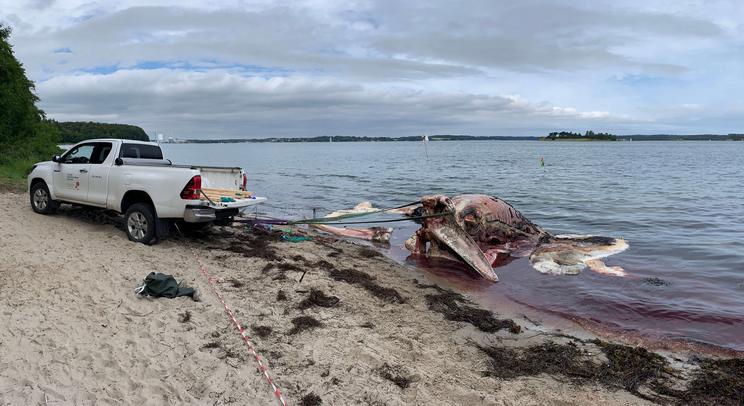
First trip to the whale carcass
On my first trip, one week after the stranding, I secured the flippers, the baleen, and the pelvic bones. To prepare the bones, Natural History Museum Denmark uses a technique referred to as maceration. Maceration is performed by carefully controlling decomposition inside a container of water at a constant temperature. In this case, the whale was slowly macerating in room temperature water, so that it was possible to progressively detach and number each bone.
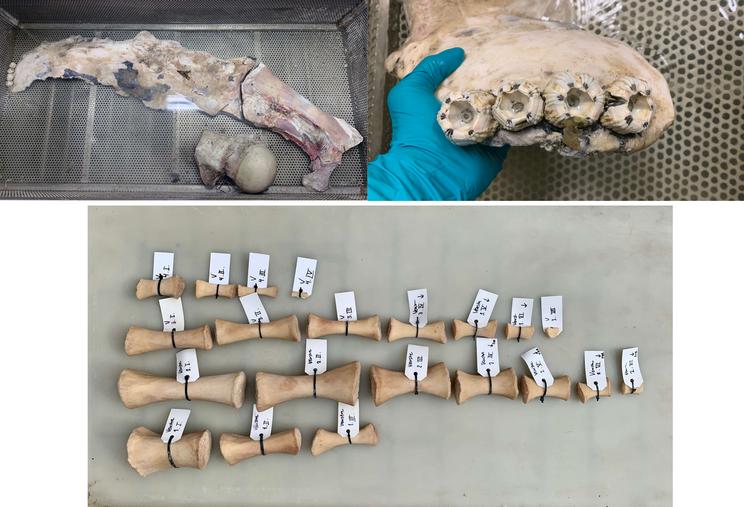
Humpback whales have enormous flippers! Even in this juvenile, roughly half the length of an adult, the flippers measured 2.5-meter – almost 1/3 of the total length of the whale. After returning to the museum and separating the upper arm bone, the flippers just barely fit into the 2-meter 1800-liter maceration tank.
Also interesting to note are the whale barnacles still attached to the left flipper and seen on the image below. Whale barnacles are typical of some large baleen whales, including humpbacks. Fun fact, an adult can carry almost 500kg of barnacles!
Baleens
The two 1.5-meter rows of baleen, perfectly intact, had already separated from the roof of the mouth, resting on the sea floor next to the head. Baleen plates consists of keratin, the same substance found in human fingernails and hair. Luckily, baleen is stable long-term, and there was no need for any interventive methods of preservation. However, the peculiar soft, fragile, and fat-like substance in which the baleen plates are anchored into is different. If left to dry, it will severely shrink and warp. As we have yet to find a convincing preservation method (if any exists?) for this substance, the entire baleen rows with the odd bases are stored on freeze. This will eventually result in a freeze-drying process of the bases that may end up being the best way to preserve them.
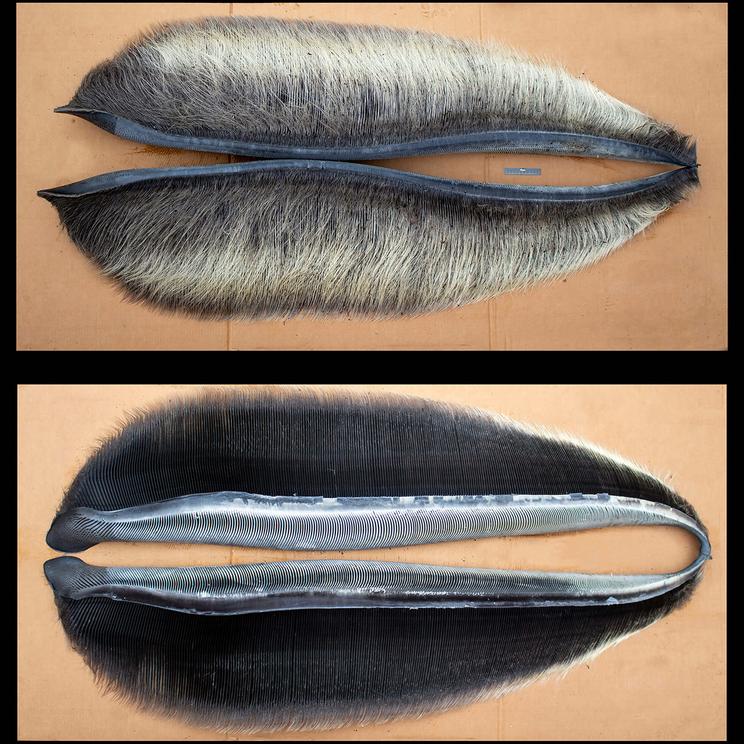
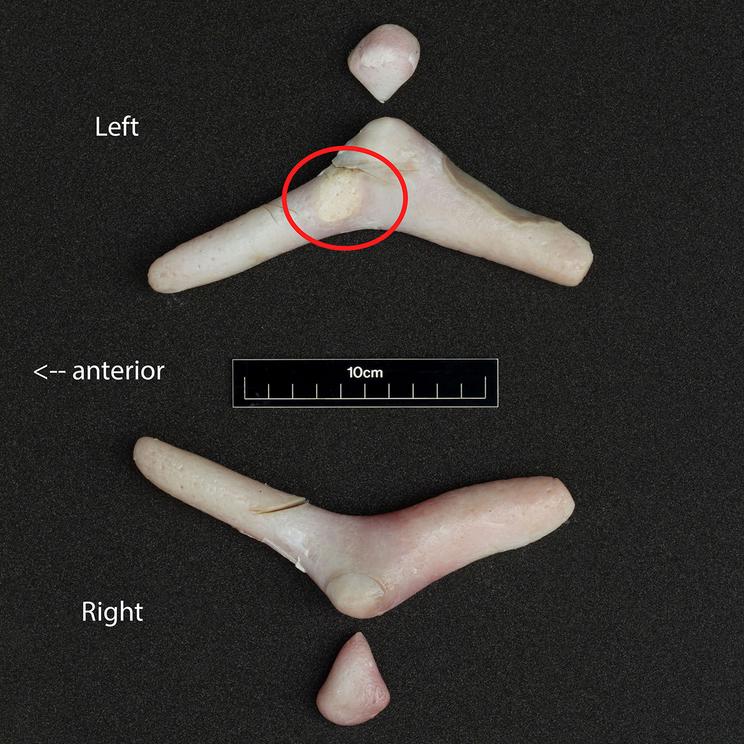
Pelvic elements
The pelvic elements in whale and dolphins are the result of an evolutionary shrinkage of their four-legged ancestors’ hindlegs. They have long been presented as "useless vestiges”, but recent research emphasizes that it still plays an important role during mating see this paper.
In juveniles, the pelvis is composed of cartilage (not yet ossified) and will severely shrink if left to dry and will disintegrate if macerated. Such soft parts are thus stored in alcohol..
Second trip – the skull
A week after the first trip (two weeks after stranding), I set off again to the whale carcass. This time the aim was to secure the skull and jaw bones.
In waist deep water, wearing waders, I separated the skull and jaw bones from the rest of the body, taking advantage of the weight and motor power of the truck to pull when needed. I now had the opportunity to test my home-made setup for pulling heavy loads without breaking the truck beds small anchoring hooks or the thin metal casing of the bed: a custom-made massive iron pipe supported by transverse pipes to the beds floor. To this, I anchored a manual chain block hoist made for 500kg, see image below.
It was indeed satisfying to manually pull the 165 kg. skull up the ramp without problems. I returned to the museum late evening, unloading the skull outside.
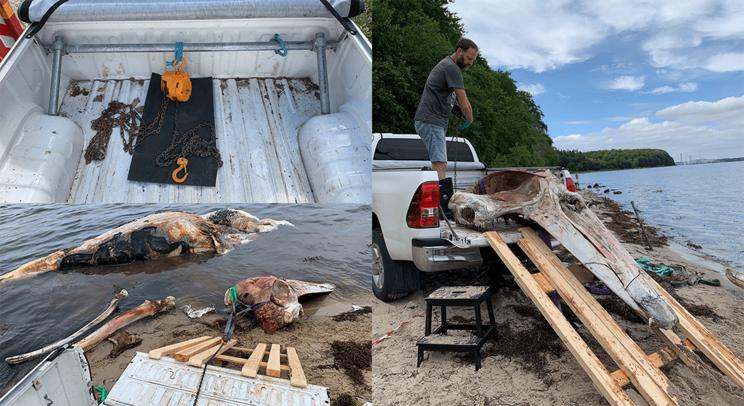
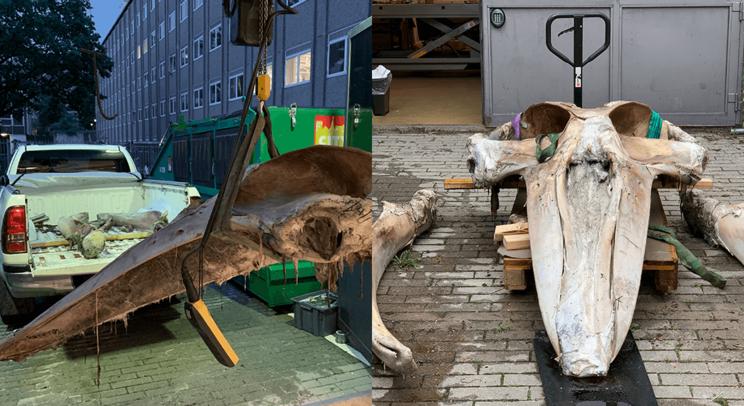
The next morning, the skull and jaws were put in our 1800-liter maceration tank. After partial maceration of the bones by the summer-warm seawater while beached, it only took a few days for the skeletal elements that make up the skull to fall apart. This allowed me to rearrange the bones to better fit the tank. Water was changed when it became dark (maceration biproducts including lipids), which is essential to a clean and uniformly coloured result.
As opposed to the flippers, which were macerated at room temperature, I macerated the skull and jaw bones at 40 degrees Celsius to allow the skeletal elements to fall apart more quickly. The warm water speeds up the process considerably and, to a certain extent, dissolves or at least liquifies some of the lipids.
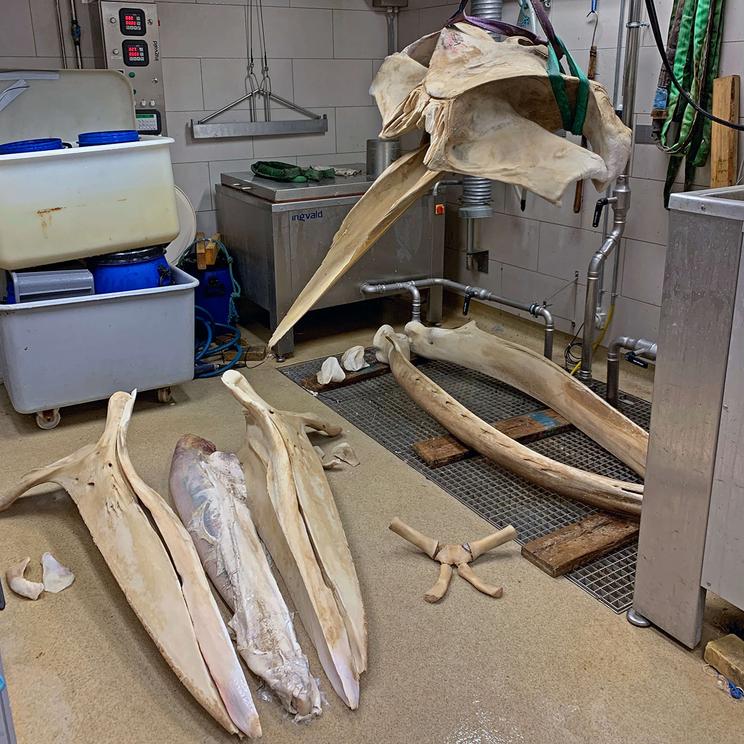
Third trip – vertebrae and more
This time (three weeks after stranding) Daniel Klingenberg, Collection Manager of mammals, joined me. The advanced level of decomposition of the carcass now allowed very easy extraction of the bones. This was very helpful, as the neck vertebrae we wanted was still close to the seabed – the whale still almost upside down – and handling big sharp knives blindly in murky water is not very safe. We could also extract the shoulder blades and inner part (upper arm) of the right flipper, which was previously difficult to cut in/access, and the first set of ribs.
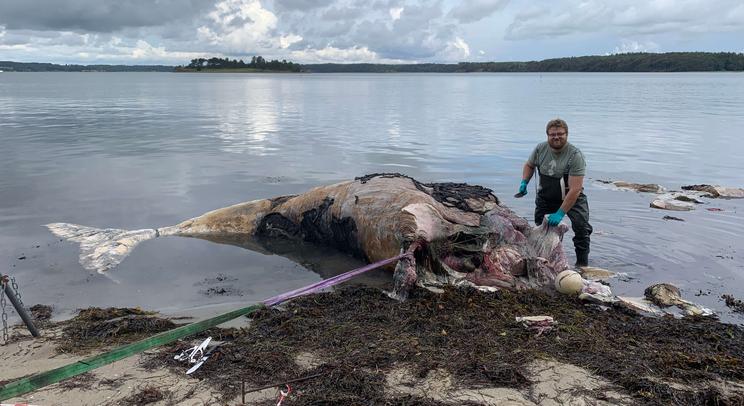
Cleaning
Bones from young vertebrates are not fully developed (ossified): it has a lighter and less dense inner structure, a more porous surface with many microscopic openings, and the epiphysial discs of long bones and vertebrae has not yet fused. This is of great help to the bone preparator, as it allows fast liquid exchange, ensuring an effective maceration and cleaning. After a few days of maceration, the water was replaced and heated to 70 degrees Celsius for 10 minutes, followed by the addition of a small amount of hydrogen peroxide for another 10 minutes. A final rinse with new water resulted in completely clean bones.
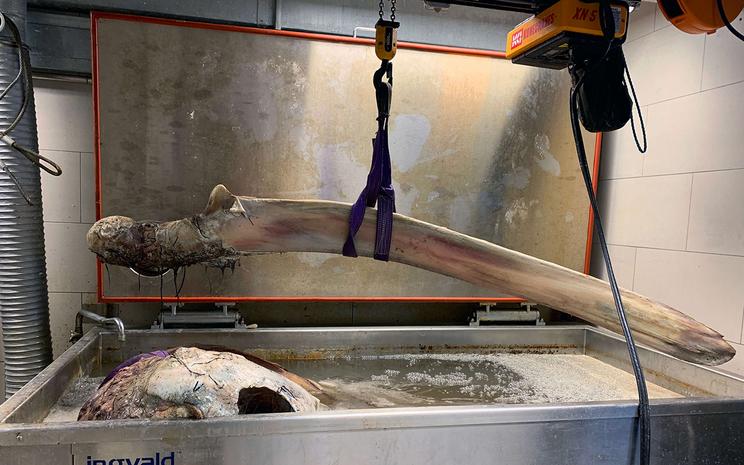
When the bones are dry (within a few weeks), the skull will be reassembled using bolts and nuts. As several contact areas of individual bone elements are thin and fragile, an assembled skull is less likely to be damaged. When entering the baleen whale collection, the skull will be stored in a supported upright position on a wheeled base. This makes studying and measuring the skull from all sides easier.
